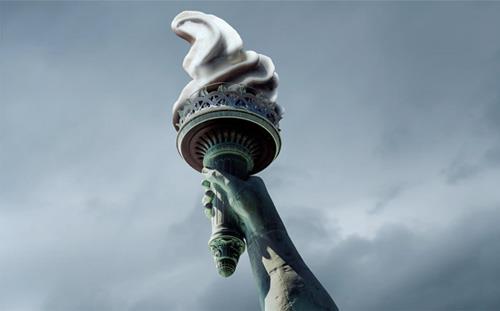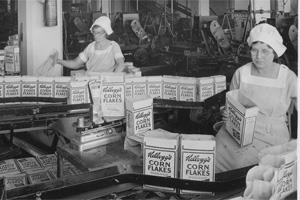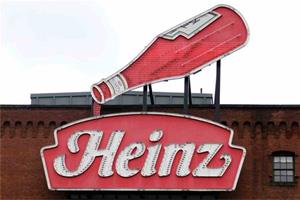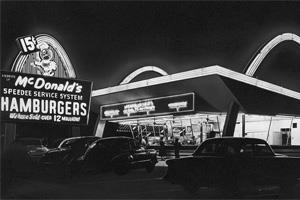
Even those of us who have been going into supermarkets for years would probably assume, if we thought about it, that food distribution has always been pretty much the way it is today.
The Food That Built America, a three-part series launching Sunday at 9 p.m. ET on History, corrects that misconception in fascinating depth.
The six-hour series, which continues Monday and Tuesday at the same time, tracks several of the major pioneering giants of the modern food biz.
That includes Henry Heinz, the Coca-Cola combo of pharmacist John Pemberton and marketer Asa Candler, brothers John and Will Kellogg, their bitter rival Charles W. Post, Milton Hershey, the McDonald brothers, Forrest Mars, and Harlan “Colonel” Sanders.
 The backstories of their entrepreneurial careers often match those of Rockefeller, Carnegie, Henry Ford, and other icons from the Wild West years of America’s expansion and industrial growth.
The backstories of their entrepreneurial careers often match those of Rockefeller, Carnegie, Henry Ford, and other icons from the Wild West years of America’s expansion and industrial growth.
Mass-marketing ketchup may not sound as glamorous as helping finance the transcontinental railroad, but in the end, it proved almost as lucrative for Heinz. The enterprise he founded today is worth some $23 billion.
And Heinz could be bought four times over by the Coca-Cola corporation, which over the last century and a half has parlayed an Atlanta pharmacist’s tonic into a worldwide value of about $100 billion.
The Food That Built America follows what has become a familiar formula for History. It tells factual real-life stories with a dramatic flair, re-enacting key scenes with live performers and not hesitating to underscore moments of crisis with appropriate music and melodramatic narration.
It can feel a little staged. But History has a good eye for stories with substance, and what we’ve got here is the origin story for much of today’s Big Food.
Which affects pretty much everyone who eats food.
 All the stories have twists, some more compelling than others. Heinz failed so badly at an earlier business that he was arrested for fraud when he couldn’t pay his creditors. John Kellogg was a doctor who developed a granola-like cereal and refused to sell it outside his sanitarium until the sanitarium burned down and he raised rebuilding cash by selling the cereal rights to his more ambitious brother Will.
All the stories have twists, some more compelling than others. Heinz failed so badly at an earlier business that he was arrested for fraud when he couldn’t pay his creditors. John Kellogg was a doctor who developed a granola-like cereal and refused to sell it outside his sanitarium until the sanitarium burned down and he raised rebuilding cash by selling the cereal rights to his more ambitious brother Will.
John Pemberton saw his coca syrup as an alternative to the hundreds of dangerous quack medications that were killing more people than they saved in the late 19thcentury. It used coca leaves, which were seen as a beneficial drug.
But Pemberton had serious problems of his own. It was only when Candler took the reins that Coca-Cola marched to international stardom.
Meanwhile, we’re also tacitly seeing the dawn of mass-produced and marketed food.
The series points out that until the 1870s, there was almost no such thing.
For starters, much more of the country still grew its own. But as the industrial revolution drove more people to the cities, where there was no farmland, more Americans began buying their food.
Because of transportation and preservation issues, stores sold almost all local food, and even then its freshness and quality were often dodgy.
An entrepreneur like Heinz saw this as an opportunity. If he could produce something that consumers trusted, and package it to last, he had a huge potential market.
 Heinz was a visionary in several areas. He set up assembly lines for ketchup the way Ford would set up assembly lines for Model-Ts. He powered his factories with electricity, rather than the traditional coal, gambling that electricity was the future.
Heinz was a visionary in several areas. He set up assembly lines for ketchup the way Ford would set up assembly lines for Model-Ts. He powered his factories with electricity, rather than the traditional coal, gambling that electricity was the future.
He won. Just as Will Kellogg won when he and early competitors like Post gambled that they could create a market for breakfast cereal. Before their products, breakfast was eggs, meat, and bread. Turned out cereal, particularly sweetened cereal, was a welcome addition.
Coke helped condition Americans to drinking soda instead of beer. Clarence Birdseye sold America on the convenience of frozen food. Mars and Hershey mined America’s latent sweet tooth.
The Food That Built America focuses more on individual stories than the cumulative impact of mass-produced food.
But that sea change flows through every story, and viewers will have no trouble extrapolating seeing how it all seeded the Big Food we know today.
Not everyone thinks Big Food is a good thing, which makes it interesting that the creators among these pioneers were all driven by an obsession to create better food.
They definitely created better food than what existed at the time. Whether it’s better than what could exist today is the open question – a question we can better address when we know how we got here in the first place.